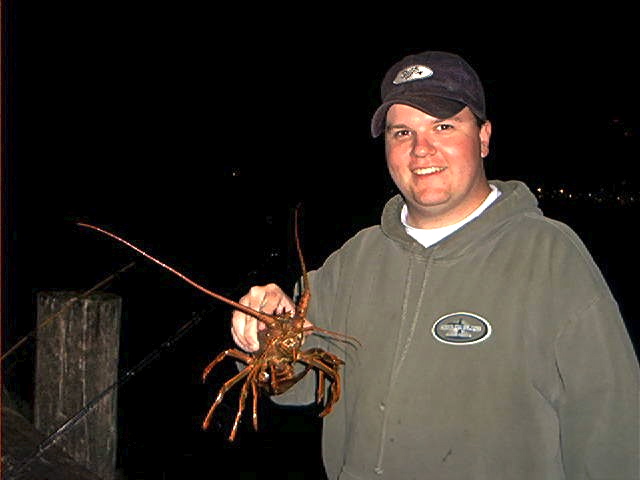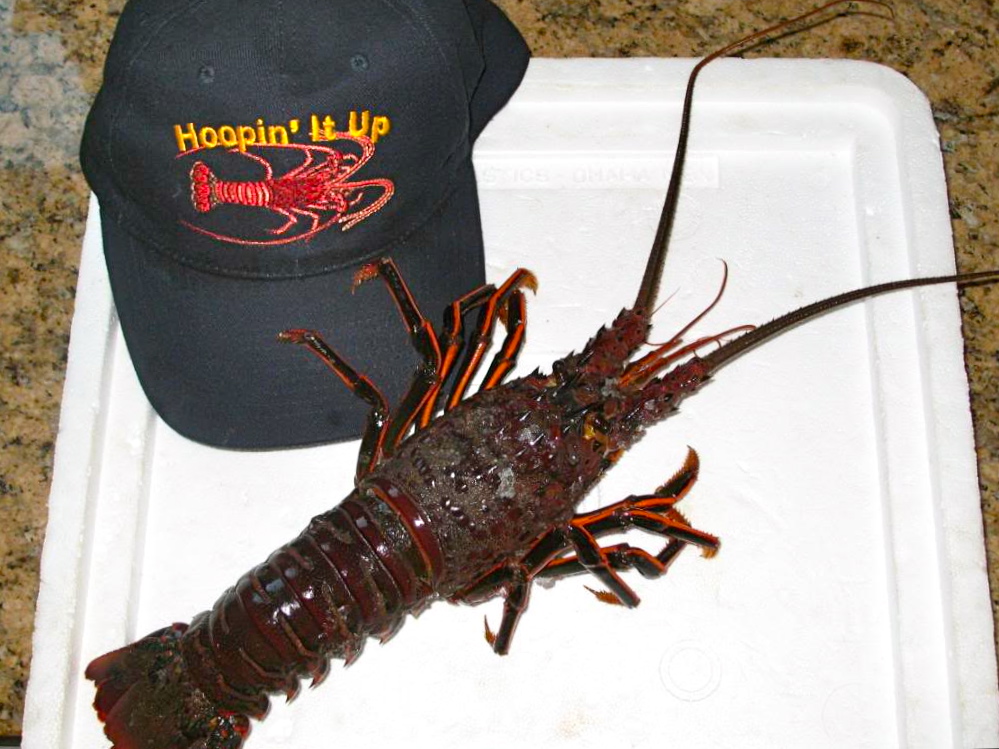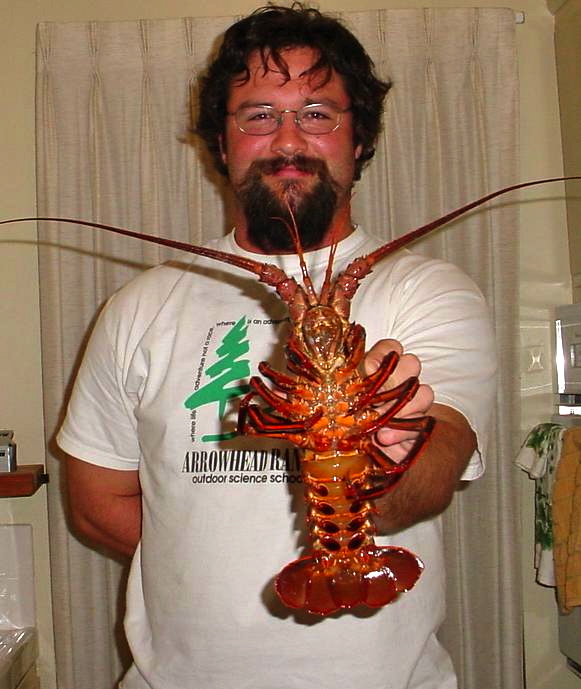Subphylum Crustacea (Crustaceans)
Order Decapoda
Spiny Lobster—Family Palinuridae
 A Spiny Lobster up close and personal
A Spiny Lobster up close and personal
Species: Panulirus interruptus (Randall, 1840); interruptus refers to the grooves on the abdomen which are interrupted in this species.
 A lobster from the Shelter Island Pier in San Diego Bay in 2009
A lobster from the Shelter Island Pier in San Diego Bay in 2009
Alternate Name: Bugs, crayfish, marine crayfish, rock lobster and red lobster. In Mexico called langosta mexicana or langosta roja. Most anglers in California simply call them bugs and greedily await the start of the “bug” season each Fall.
 Lobster taken by DompfaBen (Dominating Positive Fishing Attitude Ben) in 2004
Lobster taken by DompfaBen (Dominating Positive Fishing Attitude Ben) in 2004
Identification: Typical lobster shape, color that varies from brick-red to brown with greenish overtones, and a carapace (or back) that is very spiny with two extra large spines protruding over the eyes. Missing is the large claw that distinguishes the more famous Atlantic lobsters. At the lower edge of each of the tail segments is a large spine that can produce a painful pinch or puncture when the lobster flexes its tail.
 Lobster from Stearns Wharf in Santa Barbara in 2002
Lobster from Stearns Wharf in Santa Barbara in 2002
Size: Reported to 26 pounds and 24 inches; most caught from pier are sub-legal size and even legal ones are rarely over 5 pounds in weight. The California record is listed at 16 pounds 1 ounce taken by a diver at Catalina Island in 1968.
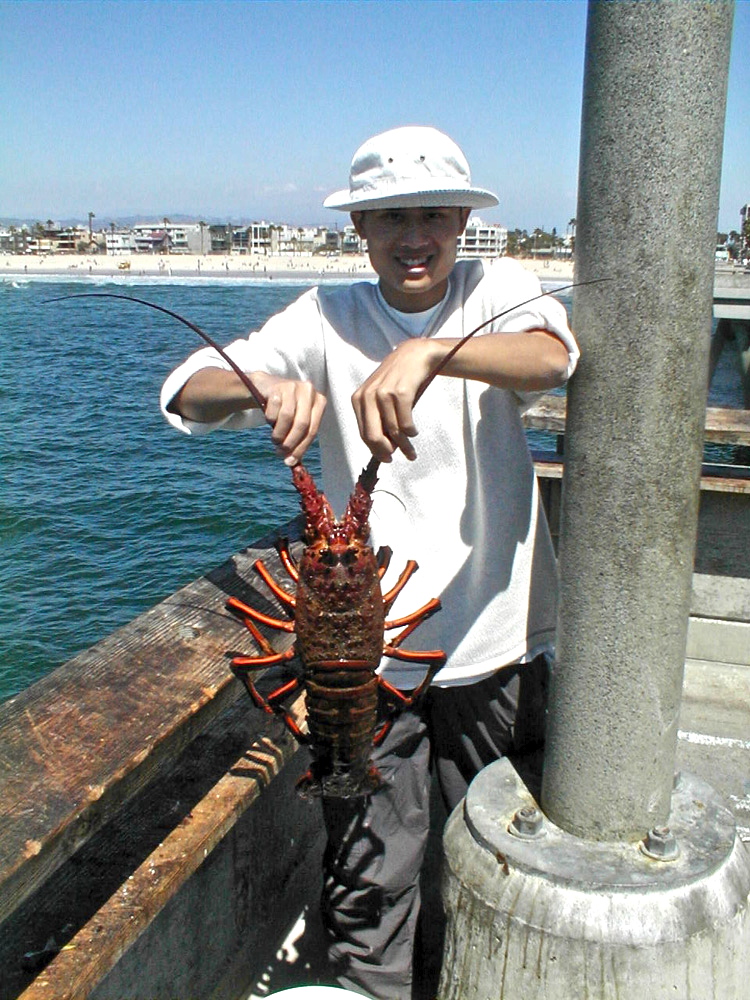 Lobster from the Venice Pier in 2003
Lobster from the Venice Pier in 2003
Range: Bahia Magdelena, Baja, California, to Monterey Bay (but uncommon north of Point Conception).
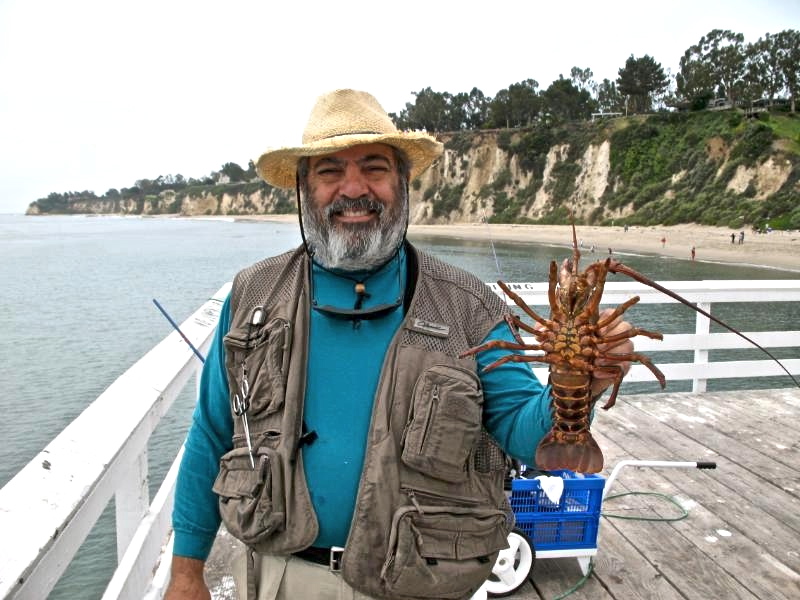 Lobster taken by Hashem at the Paradise Cove Pier in 2009
Lobster taken by Hashem at the Paradise Cove Pier in 2009
Habitat: Prefers rocky shorelines and bottoms along the coast and around the Channel Islands. Usually found in various holes and crevices during the day while venturing out to feed alone at night. Typical food includes snails, sand dollars, shellfish and decaying animal and plant matter: they’ll eat just about anything.
Baitfish (Adam) and a Stearns Wharf (Santa Barbara) lobster in 2002
Piers: A favorite goal of SoCal pier anglers during the typical October to March lobster season. Unfortunately, many piers have seen persistent and increased poaching of lobsters during the past decade and as a result few piers yield the numbers once commonly encountered. The poachers take (and keep) lobsters of every size, do so during every month (no matter the legal season), and the California Department of Fish and Game seems unable to end the problem. As a result we do not offer specific recommendations for best piers. General recommendations: 1. Most lobsters are taken at night so the piers that are open at night offer the best chance for a lobster. 2. Bugs are typically found along rocky shores and bottom areas that contain rocks so piers that have that type of bottom, or that have reefs near the pier, generally yield the best results. The number one pier in the state for lobsters was the Cabrillo Mole at Avalon on Catalina Island. However, as of 2015 it is illegal to take lobsters from the Cabrillo Mole.
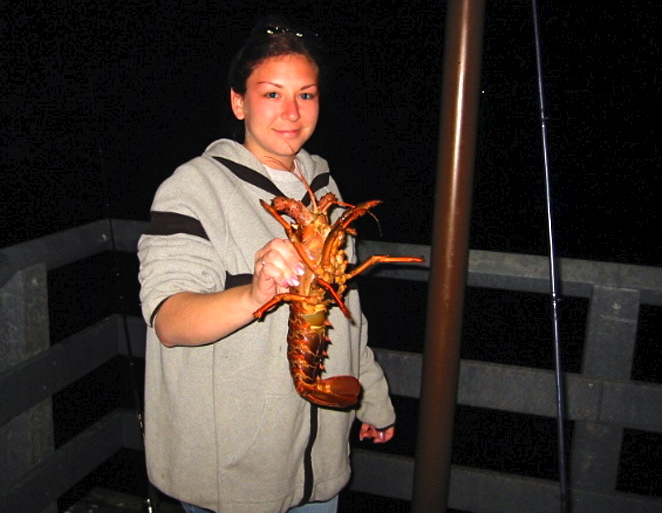 Lobster taken by Lisa at the Green Pleasure Pier in Avalon in 2002
Lobster taken by Lisa at the Green Pleasure Pier in Avalon in 2002
Shoreline: Taken by hoop nets in rocky areas.
Boats: Taken by regular boaters and kayakers venturing into their shallow water, rocky habitat.
 Lobster taken by DompfaBro in 2007
Lobster taken by DompfaBro in 2007
Bait and Tackle: Spiny lobsters are most commonly taken by using hoop nets. Bait varies but fish scraps are probably the most prevalent bait used to catch them (and cans of cat food are favored by some of the people on the Pier Fishing in California Message Board). While many lobsters are accidentally hooked on fishing lines, and give really big surprises to the anglers who pull them in, it’s against the law to keep them.
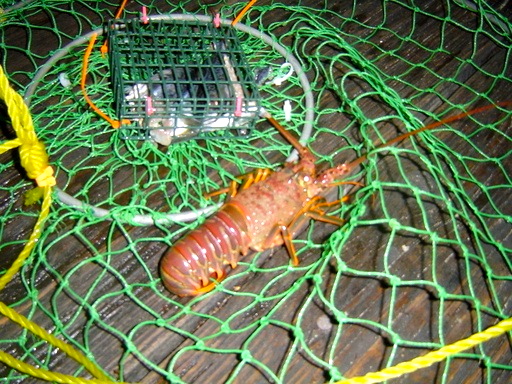 Lobster taken at the San Clemente Pier in 2010
Lobster taken at the San Clemente Pier in 2010
 Checking the size of a lobster at the Ventura Pier in 2007
Checking the size of a lobster at the Ventura Pier in 2007
 Hashem checking the size of a lobster at the Cabrillo Mole in Avalon in 2014 [Lobsters can no longer be taken at the Cabrillo Mole]
Hashem checking the size of a lobster at the Cabrillo Mole in Avalon in 2014 [Lobsters can no longer be taken at the Cabrillo Mole]
It’s too small, a quick kiss and back into the water — Hashem at the Cabrillo Mole in Avalon, 2014 [Lobsters can no longer be taken at the Cabrillo Mole].
Food Value: Excellent eating!
 Yummy! A mess of lobster from the Cabrillo Mole in Avalon in 2010
Yummy! A mess of lobster from the Cabrillo Mole in Avalon in 2010
 A little variety for dinner — lobster, sheephead, opaleye and kelpfish — all from the Cabrillo Mole in Avalon in 2010. Today it’s against the law to catch lobsters at the Mole.
A little variety for dinner — lobster, sheephead, opaleye and kelpfish — all from the Cabrillo Mole in Avalon in 2010. Today it’s against the law to catch lobsters at the Mole.
Comments: As with crabs, be sure to check current Fish and Game regulations before you go after the “bugs.” Minimum size restrictions, approved seasons, and legal bag limits will all be explained. In addition, all people seeking lobsters need to have a “Lobster Card” on which they must record their take throughout the year.
 Hashem (Mahigeer) at the Hermosa Beach Pier with a small lobster in 2004
Hashem (Mahigeer) at the Hermosa Beach Pier with a small lobster in 2004
 A nice lobster taken by Brady in 2004
A nice lobster taken by Brady in 2004
 A good-sized lobster taken from the Santa Monica Pier in 2003
A good-sized lobster taken from the Santa Monica Pier in 2003
DompfaBen and a lobster in 2004
 A lobster taken at a “Kid’s Fishing Derby” at the Shelter Island Pier in 2009
A lobster taken at a “Kid’s Fishing Derby” at the Shelter Island Pier in 2009
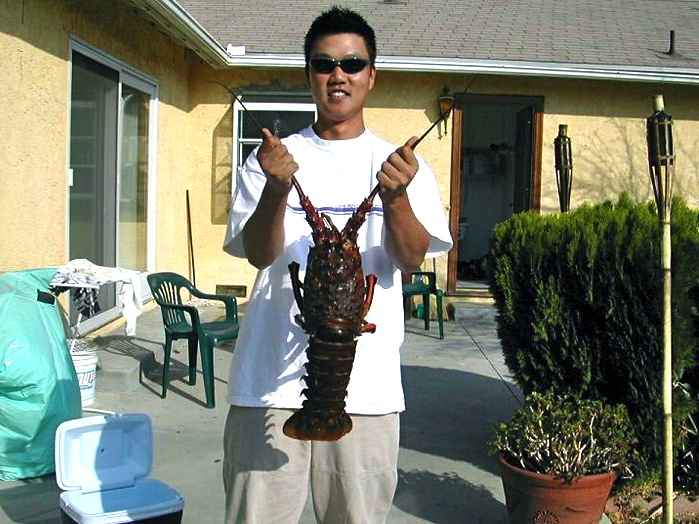 Lobster taken by “Catfish” at the Santa Monica Pier in 2003
Lobster taken by “Catfish” at the Santa Monica Pier in 2003

 A nice lobster from the Oceanside Pier in 2005
A nice lobster from the Oceanside Pier in 2005
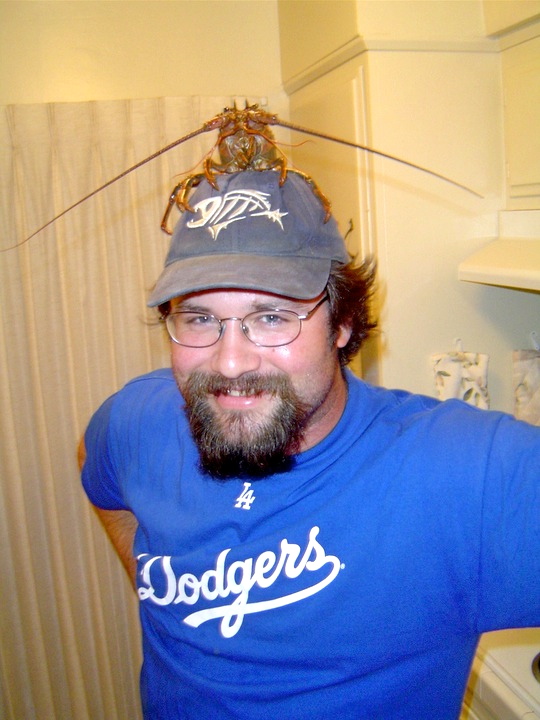 DompfaBen and two of his favorite things — a lobster and his Dodgers
DompfaBen and two of his favorite things — a lobster and his Dodgers
 Looks like a nice combo dinner — Lobsters and crabs taken from the Santa Monica Pier by Baitfish (Adam) in 2003
Looks like a nice combo dinner — Lobsters and crabs taken from the Santa Monica Pier by Baitfish (Adam) in 2003
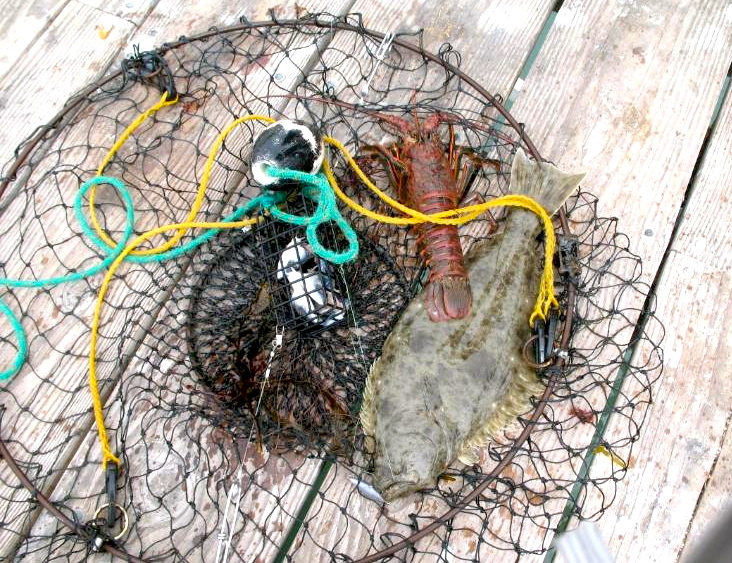 An unusual combo. I had hooked a halibut and asked Hashem to use his crab hoop (which was sitting in the water) to net the fish. When he pulled it up there was also a lobster in the net. At the Paradise Cove Pier in 2009.
An unusual combo. I had hooked a halibut and asked Hashem to use his crab hoop (which was sitting in the water) to net the fish. When he pulled it up there was also a lobster in the net. At the Paradise Cove Pier in 2009.
__________________________________________________________________________________
The Panulirus Creed
Posted by DomphaBen to the “Pier Fishing In California Message Board” on November 17, 2004
With apologies to all of my parochial school teachers…
The Panulirus Creed, (based loosely on the Nicene Creed)
We believe in one Lobster,
the Benthos, the All-Spiny,
taker of hoop-bait and mirth,
of all that is, seen and unseen.
We believe in one Pull, Heavus Heist,
the only Fun of Cod,
eternally begotten of the Benthos,
rod from rod, Light-line from Light-stick,
huge bug from true tug.
Be-boiled, not filleted,
of one Being with the Gauge.
Through him my dinners were made.
For us and for our salivation
he came out from reef-haven:
by the power of the Holy Mackerel
he became netted from the Sturgeon Scary,
and was made 1/7 of a limit.
For our sake he was boiled under Caphalon;
he ruddied, died and was buttered.
In a few minutes he was sliced and eaten
in fulfillment of the Pictures;
he descended into my belly
and is seated at the right hand of my love-handle.
He will come again in plumbing to sludge the living and the dead,
and his memory will have no end.
We believe in the Holy Mackerel, the bait, the giver of Lobster,
who proceeds from the Squid and the Sabiki.
With the Squid and the Sabiki he is frozen and zip-tied.
He has spoken through PFIC.
We believe in one holy, aesthetic, and sanitary Pier.
We acknowledge one license for the avoidance of poaching.
We look for the resurrection of the kelp,
and the capture of Lobster to come.
Amen.
in nomini panulirus, spiny, et sabiki sancti…
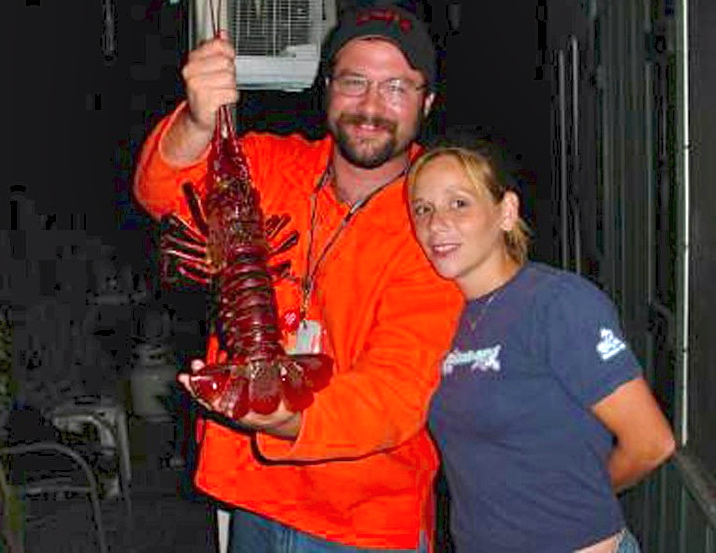 One more DompfaBen lobster. This time in 2003 with wife Brandy.
One more DompfaBen lobster. This time in 2003 with wife Brandy.
__________________________________________________________________________________
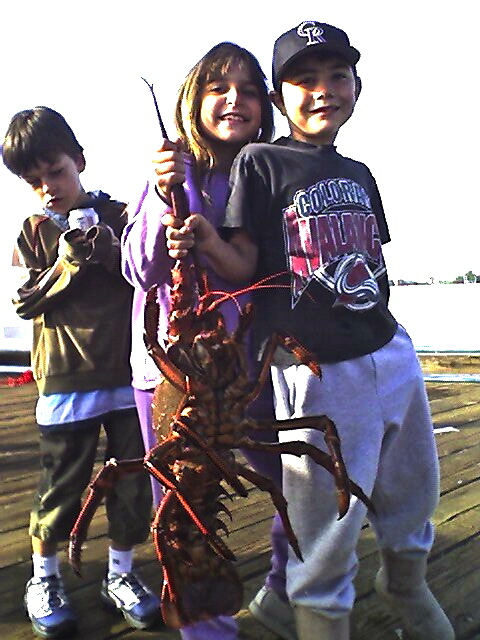 Lobsterilla — Persevering twins reap late reward of one giant lobster
Lobsterilla — Persevering twins reap late reward of one giant lobster
Ed Zieralski, San Diego Union-Tribune, October 20, 2002
It was another marathon Saturday with dad, starting with a 6:30 a.m. tee time and finishing at midnight at the Oceanside Pier.
But it turned into a very special day for Blake and Garett Spencer, a pair of 9-year-old twins who teamed with their father, Todd, to catch a lobster of a lifetime.
“Saturday is my day with the boys, and we started with 18 holes at Temeku (Golf Course),” said Escondido’s Todd Spencer, manager of a collection agency.
From there, it was on to Oceanside Pier for some hoop-netting for lobsters, an activity the boys later told their dad they’d pick over playing video games.
“This was only our second time hoop-netting,” Spencer said. “We went at the end of last season and fished off Ocean Beach Pier. We didn’t get anything, but the boys loved it.”
Last Friday, the boys asked their father: “When are we going lobster hunting again?”
Spencer promised they’d go after his golf outing the next day. They packed their rig with items that don’t necessarily go together like ham and eggs: dad’s golf bag and gear, a couple of hoopnets and 21/2 pounds of mackerel for lobster bait.
Golf and hoop-netting, an outdoorsman’s daily double, for sure.
Golfing done, Spencer said they arrived at the Oceanside Pier at 6 p.m. and started fishing the windward side of the pier.
“We were the only ones with hoopnets, and I was beginning to think the Oceanside Pier wasn’t the right place to hoop-net for lobsters,” Spencer said.
He turned to his boys after a few hours of not getting anything and asked them, “Would you guys rather be home with your new X-Box games, or would you rather be out here on the pier fishing and not catching anything?”
They chose being on the pier over playing video games. This was more fun, and besides, it was quality time outside with dad.
“That made me feel pretty good,” Spencer said. “I’m from Northern California. I grew up in the foothills of Yosemite, out in the country. My kids are city kids, but they have the same interests I have. They love being outdoors.”
Shortly after their talk, Spencer switched to the leeward side of the pier, and the change produced two short lobsters, each about 1/4-inch short, just after 10 p.m. They sent them back like good sportsmen.
Another pick of the net produced a giant spider crab, about a 6- or 7-pounder, Spencer said. He was about to throw it back, but a man told him to keep it because it was very good eating.
“It looked nasty, but he said it was good,” Spencer said. “I cooked it later, and it not only looked nasty, it tasted nasty. Next time, it’s going back into the water.”
The spider crab provided a thrill to Spencer and his boys, and since it was getting close to midnight, Spencer felt it was time to go.
But then Spencer heard the cry of, “C’mon dad, one more pull, one more pull before we go.” “One more pull” to a hoop-netter is what “one more cast” is to a fisherman, what “one more shot” is to a bird hunter.
Spencer gave in. They made a set, left it for a while and made one more pull.
“It was the last pull of the night,” Spencer said.
And what a pull.
As the net came up, Spencer and his boys couldn’t believe their eyes. There in the net was what Spencer later called the “mutant lobster.” He never weighed the giant crustacean, but, including its antennae, the giant bug was at least 46 inches long, nearly as tall as his boys, who are 56 inches tall. He estimated it at 15 pounds.
California spiny lobsters have been known to go as high as 25 to 30 pounds. Biologists figure a lobster that big could be anywhere from 50 to 150 years old.
“I have a friend who dives, and he’s saying it’s a minimum of 15 pounds,” Spencer said. “I wish now I would have taken it to a supermarket or somewhere and weighed it,”
Spencer and his boys celebrated the next day with a lobster feast.
“You know how people say the big old lobsters are tough and not good eating,” Spencer said. “That’s not so. This lobster was tender and sweet. Really god eating.”
Looking back, Spencer said he likely would have quite around 9 p.m. had the boys chosen to go home to play video games.
“It was all because they wanted to stay,” Spencer said. “It was our day out. And what a fantastic day.”
____________________________________________________________________________________
Regulations: [What You Need to Know to "Stay Legal" — From California Department of Fish and Wildlife]: (1) A California sport fishing license with ocean enhancement stamp is required to take lobster south of Point Arguello. The license must be displayed by hoop netters, and divers must keep their fishing license either aboard the vessel or, if beach diving, with their gear within 500 yards from shore; (2) A Spiny Lobster Report Card is required for every person fishing for or taking spiny lobster. This includes persons who are not required to have a sport fishing license, such as children under the age of 16, persons fishing from a public pier, and persons fishing on free fishing days. Report cards must be carried by hoop netters, and divers must keep it with their fishing license. Just like the sport fishing license, report cards are valid from January 1 through December 31. If a lobster fisherman fills up a card before the year ends, the card can be returned and a new one purchased. The Spiny Lobster Report Card must be returned to the Department no later than January 31 of the following year; (3) The spiny lobster open season runs from the Saturday preceding the first Wednesday in October through the first Wednesday after March 15 (the first Wednesday in October is when commercial season opens; (4) No implements other than hoop nets may be used to take lobster. Divers may only use their bare or gloved hands to take lobster; (5) Both lobster divers and hoop netters must carry a lobster gauge when attempting to take lobster. The gauge is a metal or plastic measuring device that has a fixed gap of 3¼ inches for determining the legal size of the lobster. Lobster gauges can be purchased at most dive and tackle shops. Divers may bring lobster to the surface of the water for the purpose of measuring, but no undersized lobster may be retained by the diver, brought aboard any boat, or placed in any type of receiver. Hoop netters are required to measure lobster immediately upon retrieving their net, and any undersized lobster must be released immediately; (6) The lobster daily bag and possession limit is seven (7) lobsters. This includes any lobster stored at home or elsewhere; at no time may more than seven lobsters be in anyone’s possession; (7) A maximum of five (5) hoop nets may be fished by an individual, except on piers, jetties, and other shore-based structures where each angler is limited to two (2) hoop nets. No more than 10 hoop nets may be fished on a vessel, regardless of how many licensed anglers are aboard; (8) It is illegal to disturb or rob commercial lobster traps.
How to Measure Lobster — To determine whether the lobster you’ve just caught is large enough to keep, you must measure the length of the body shell, or carapace, along the midline from the rear edge of the eye socket (between the horns) to the rear edge of the carapace with a lobster gauge (see diagram above). This straight-line measurement should be a minimum of 3¼ inches. The carapace of a legal-sized lobster is larger than or equal to the gauge’s cutout. If the lobster is too small, it should immediately be released back into the water. Undersized lobster should never be brought aboard a vessel, or ashore if diving from the beach. Current spiny lobster sport fishing regulations can be found in the Ocean Sport Fishing regulation booklet, available at most sporting goods stores and wherever fishing licenses are sold, or on the Department of Fish and Game Web site at:
www.dfg.ca.gov/regulations


